Mitre House, Abbey Road, Enfield, EN1
Infogrames, the company whose bloody fingerprints are all over the dagger in the back of the corpse of the UK software industry.
Melodramatic stuff eh? Not strictly true of course but that's why I keep all the boring context away from the clickbait introduction. Did Infogrames kill the UK software industry? No, that's delicious hyperbole but when Infogrames absorbed Gremlin and Ocean they accelerated a process which had been going on through the nineties. The big beasts of the software industry were going extinct and Gremlin and Ocean joined Mirrorsoft, Domark, Mastertronic, and more, on the list of publishers who were taken over, went bankrupt, or just closed down. Today the UK software industry is dominated by developers, the reverse of how it looked in the eighties.
Infogrames was founded in 1983 in Lyon. They made their entry into the UK market in the summer of 1986 and COMPUTER & VIDEOGAMES described them company as:
...probably the biggest software house in Europe.
At its headquarters in Villeurbanne, Lyon, it employs 84 people, nearly half of them programmers working in new games, conventions and developing new product...
And now Infogrames is preparing to take on the British market. This summer will see the first of its games released in Britain Mandragore, an arcade adventure which has already proved a massive hit on the continent. (August 1986 page 44).
Mandragore was released on all the usual machines, Spectrum, C64, and Amstrad, plus the Apple II and MSX. The UK advert and packaging carries the head office address in France, 79, rue Hippolyte-Kahn - 69100 VILLEURBANNE - FRANCE (and if you live in Lyon, please snap a photo of 79 rue Hippolyte-Kahn and send it to whereweretheynow@gmail.com); suggesting Mandragore was released before Infogrames moved into Mitre House.
Packaged with CRASH issue 32 was a four page promotional supplement called LE TATOU which names Mitre House and prints a photo, and also lists release dates for the next seven titles; July, The Expert, some sort of artificial intelligence programme which I'm not sure ever went on sale; August, Illusions and L'Affaire Vera Cruz, although there seemed to be some doubt within the company about what this game was called, the instruction manual gives it the French title, the box shortens the name to Vera Cruz, and adverts refer to the game as The Vera Cruz Affair; September, The Inheritance: Panic at Las Vegas, Bridge, and Murders on the Atlantic; November, The Quest of Artilac.
 |
| LE TATOU, issue one 1986 |
Infogrames supported all the major UK formats including the new 16-bit Amiga and Atari ST. Their catalogue included some impressive games that were just what I wanted to show off the capabilities of my shiny new Atari ST; the alien fractal weirdness of Captain Blood, and the comic book fun of North and South and Tintin on the Moon.
 |
| Back cover of Welltris, 1991 |
Here's the problem, it gets difficult to track Infogrames because at some point they became incredibly bad at putting their address on things. It's difficult to be precise but after 1990 the company prefers a cheaper three language design which can presumably be made centrally and shipped across Europe as needed (note the stuck on barcode for the UK on the back of Welltris). How did people contact the company with faulty games? My guess is a cheap insert slipped into the packaging which hasn't survived. Or maybe it has. I don't know. Normally I'd find a nice comprehensive list of Infogrames titles and see what documentation has survived to be digitised and put online but the convoluted corporate history of Infogrames makes this really difficult. Want to know what games Infogrames UK released? Well tough. Here's the Mobygames entry. It's all the games released by all the companies intertwined in the Infogrames family tree, plus some that weren't; bet you didn't know Infogrames released Donkey Kong in 1981, Mobygames says they did. Oh, and note that entry is called Bandai Namco because that's the company which owns Infogrames UK today. If you look up the entry which actually has the name Infogrames in it, you get Gremlin Graphics. In the end I found the right page on Mobygames, it was called Atari Europe... aargh!
Oh stop whining, I hear you say. Why don't you just look at the Companies House records like you always do. Okay wise guy. Which record? Bandai Namco starts off as Ocean, becomes Infogrames from 1998 to 2003, and then morphs like the T-1000 into Bandai Namco via Atari. Companies House does carry a record for Infogrames Limited, it was incorporated on 14th February 1986 (romantic) and dissolved on 19 September 2013. Dates check out. Disappointingly, it lists a lot of corporate addresses that I suspect are the addresses of whatever law/accountancy firm ran Infogrames business affairs.
In summary. I'm not sure how much of what follows is accurate but let's go anyway.
18 Old Town, Clapham, London, SW4
I know Infogrames was in Clapham by late 1991. Did they move there from Mitre House? It seems a long way to trek across London.
Clapham Old Town is very trendy these days. It's considerably more trendy and desirable than it was around 1991 when THE ONE published their Software Landmarks of the UK article (October 1991 page 52). That article's London map shows Infogrames joining Domark, in Putney, and Accolade, in Battersea, to form an arc of software houses across Wandsworth and into Lambeth; although THE ONE's claim that Infogrames are in Battersea is out by a couple of miles. The ex-Infogrames building is just round the corner from Clapham Common, that's both the common and the tube station. It's an eight minute walk from the station unless you go the way I did, which involves going the wrong way and doubling the distance.
14 Smedley Street, Clapham,SW4
 |
| February 2024 |
I'd been fussing around on the other side of the road from 14 Smedley Street, trying to work out the best way to get a picture of the building. I'd walked up and down, tried portrait and landscape views, and finally settled on a wide angle photograph. It was clearly the best I was going to do on a narrow street with lots of parked cars. While I'd been doing this, I'd ignored the house right behind me and the person who lived there had spotted me and come out to check I wasn't doing anything too antisocial.
I tried not to look guilty as I gave a potted version of what I was up to; on the rare occasions when this happens I just say I'm writing an article about a company who used to be based in the building. I chatted for a bit, ignoring the dog snuffling around my ankles and got some interesting information. Mainly that the whole building was rebuilt "years ago." The builders did a good job of making it look Georgian, I certainly assumed it was, but on closer inspection the brickwork above the shop is not very weathered and I wonder if the top floors were taken down and rebuilt. The building sits on the corner of Smedley Street and Larkhall Lane. On the other side of the junction are numbers 2 to 8 Smedley Street, the ground floor shop is at 155 Larkhall Lane, and then there are the three doors in the photo above; I assume these are numbers 10,12 and 14. Which would make the door to number 14, the one closest to the red-brick wall.
How long was Infogrames at Smedley Street? I'm not sure how long they were at 18 Old Town. I've already whined about the difficulty of finding solid information but after being quite rude about Mobygames, they helped by supplying this advert for Alone in the Dark which shows Infogrames were still at 18 Old Town in January 1993. The best I can say is that Infogrames was definitely in Smedley Street by March 1994 and they were still there in August 1996; when the company was offering a free Sherriff's badge to promote Alone in the Dark 3.
The conversation ended with the local apologising for coming out and asking me what I was doing. I tried to be magnanimous and said, "don't worry, you did exactly what you should have done." And then I walked off worrying this was exactly the sort of thing a cat burglar planning a raid would say. For added suspicion, while trying to find a way through to Clapham Road I blundered into the grounds of Larkhill Primary School at the end of Smedley Street.
31 Welbeck Street, London, W1M
If you go by the Companies House record then company number 01989455, Infogrames Limited, was based in central London. It probably wasn't. It was, I think, the registered business address while the company traded out of Enfield and then South London.
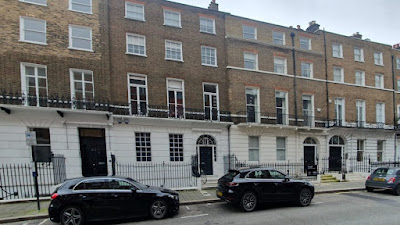 |
| February 2024 |
Now that's a Georgian terrace. You can see why I was confused by 14 Smedley Street but there is a difference.
Wellbeck Street is in the Marylebone area of London. I've been here before. Mastertronic's first office was barely round the corner at 54 George Street; in a similar terrace of four-story Georgian houses. Activision's first London office was also in the same area. While researching this history I started to take against Infogrames a bit because it felt like the company wasn't taking me anywhere new. Activision was a chore but at least the company took me all across London and the Thames valley. Enfield and Clapham were as exotic as my February trips got.
2nd floor, The Quadrangle, 180 Wardour Street, London, W1V
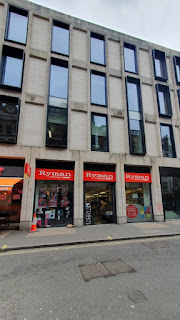 |
| February 2024 |
That's possibly the driest sentence I've written for this blog. Why is it interesting? A First Gazette notice for compulsory strike-off is the first step in the process of dissolving a company.
Briefly, the London Gazette is one of three (London, Edinburgh, and Belfast) official journals of record for the British state. When a company fails to comply with Companies Act regulations then Companies House itself can begin the process to shut down the company. Placing a notice for compulsory strike-off is step one of a two month process and on 4 April 1995, Infogrames Limited was officially dissolved and no longer allowed by law to do business. This is quite bad. What went wrong? At the end of the year there's a flurry of official documents; registered accounts for 1993, 1994, and 1995; and a full list of members (directors, company secretary, etc). The same day the company is restored to the Companies House register and allowed to trade again.
It looks as if Infogrames failed to file three years of accounts, and Companies House lost patience. What was going on inside the business? I don't know, but by autumn 1995 Infogrames would have been keen to get back on the register because they were in negotiation with Ocean about a merger. Paul Patterson told OCEAN THE HISTORY, by Chris Wilkins and Roger Kean:
"It became apparent from the autumn of 1995 that while Ocean was enjoying success in the charts and had some very lucrative bundle deals it wasn’t enough to cover our incredibly large overhead. David started talking to Infogrames about a possible sale. Infogrames wanted to raise their profile worldwide and in their words they wanted to buy the “rock ’n’ roll” company – Ocean."
This deal was done in 1996 and began a four year phase of what Wikipedia describes as "growth through acquisition." Three months later, Infogrames moved its registered address from London to Ocean's offices in Manchester.
2 Castle Street, Castlegate, Manchester, M3
Three new directors of Ocean Software were appointed on 09 Aug 1996. Bruno Bonnell and Christophe Sapet, founders of Infogrames SA in 1983, and Thomas Schmider, who joined just after it was founded. Going the other way, Ocean founder David Ward didn't become a director of Infogrames Ltd until 2001. His co-founder Jon Woods never did, and resigned as a director of Ocean in 1997.
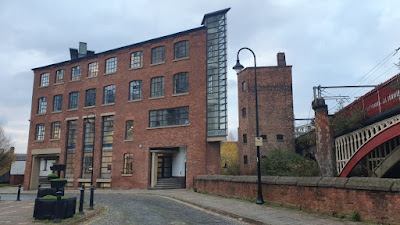 |
| December 2022 |
David Ward told OCEAN THE HISTORY:
[The merger] was the correct thing to do. It made us part of a worldwide company – you couldn’t compete any longer on a national basis only. You had to be a worldwide player to get access to creative resources and access to the product categories – you needed a global footprint. And Infogrames were very motivated about that and they had a second string to their agenda which was to buy GT Interactive.
GT Interactive would be added to the company in 1999. Along with Gremlin Graphics (1998), Accolade Inc (1999), and Hasbro Interactive (2001). The Hasbro deal stands out to me because it was how Infogrames came to own MicroProse. They were a company who had been huge in the early nineties and fallen on hard times. To get an idea of how well the Infogrames growth spurt worked go back to the January 1990 issue of THE ONE. Look at those start of the nineties adverts; Ocean advertise on pages 2 and 3, 48, 88, 110, 127, and 131; Accolade are on pages 11 and 85; MicroProse on page 13, 15, 114, 117; and Gremlin (in a slow month for them) on page 91. That's 14 pages of adverts from a 132 page issue. Now all that was owned by Infogrames. The only company to escape Infogrames' maw was Eidos, a deal with them was proposed in October 2000 but didn't happen.
I'm getting ahead of myself.
21 Castle Street, Castlegate, Manchester, M3
Ocean and Infogrames both moved again in September 1997, to slightly further down Castle Street. Infogrames set up a website in 1996 and you can see the early pages archived at the Wayback Machine. The Company Overview page gives a brief thumbnail description of the company at the time:
A good command of European distribution is one of the principal strengths of Infogrames Entertainment. At this time, the Group is located in Cologne (Germany) for German-speaking countries, in Brussels (Belgium) for the Benelux countries and in London / Manchester (England) for Commonwealth countries.
Infogrames had no nostalgia for the Ocean name. The company was rebranded Infogrames United Kingdom in 1998 after Bruno Bonnell announced:
"his company is standardizing its various interests under the single brand banner of Infogrames: Ocean, for example, becomes Infogrames United Kingdom Ltd."
Infogrames Ltd and Infogrames United Kingdom Ltd became two branches of the corporate family tree. It could get confusing because I'm dealing with three companies all called Infogrames. There's the French parent, Infogrames Entertainment SA, IESA, and for simplicity, if not accuracy, I'm going to refer to Infogrames/Ocean for the company formed by the merger and Infogrames Ltd for the original UK branch of the French parent. Following the rebranding, Gremlin Graphics would become Infogrames Sheffield House, MicroProse was renamed Infogrames Chippenham, and when Infogrames/Ocean decided it wanted to return to London their office at 21 Castle Street became Infogrames Manchester.
Landmark House, Hammersmith Bridge Road, London W6
Infogrames/Ocean moved its registered address to London in December 2000. It wasn't until a year later that Infogrames Ltd also changed it's address to Landmark House in Hammersmith.
MicroProse UK finally ceased to exist when Infogrames Chippenham, was closed in 2002. Infogrames Sheffield House, *cough*Gremlin Graphics*cough* was closed in 2003. The same year Infogrames/Ocean changed its name as part of a massive global branding. The Hasbro acquisition brought with it the rights to the Atari name and Infogrames/Ocean became Atari United Kingdom on 13 May 2003. The French parent kept its original name, everyone else became Atari something-or-other. Then, 2005 saw the closure of Ocean, or rather Infogrames Manchester, or was it Atari Manchester by that year? Through all this frantic rebranding Infogrames Ltd kept its original name and was quietly ticking over in the background. David Ward resigned as a director of Infogrames Ltd in January 2005. He stayed on as a director of Atari United Kingdom (remember folks this was the new name for Infogrames/Ocean) and resigned on 1 January 2006.
Buckle up, because now things get messy. IESA was losing money hand over fist. It turned out that growth through acquisition was expensive and built up a lot of debt. IESA began to divest all the properties it had brought in the previous years. The Atari-owned digital rights to Hasbro games were sold back to Hasbro in 2005; that's probably 32% of the flaws of capitalism right there in one sentence. Then Bruno Bonnell resigned in 2007. While all this was going on, where was the company based now? Here.
 |
| February 2024 |
That empty space is where Landmark House was. It was pulled down around 2019. If you want to see the building in all its glory you need to look at the Google Streetview archive.
2008 Onwards
Right. Bear with me while I try to keep track of everything. We're dealing with three companies. Infogrames Entertainment SA, the original French company. Atari United Kingdom, the rebranded Infogrames/Ocean. And Infogrames Ltd, the original British company set up in 1986.
Atari United Kingdom went into partnership with Bandai Namco, and in 2008 set up a jointly run distribution business called Distribution Partners. Bandai Namco brought out the business in 2009. So, If you want to see where the long and winding road of Ocean\Infogrames\Atari\Bandai Namco ends up. It ends up here.
37-39 Kew Foot Road, Richmond, Surrey, England, TW9
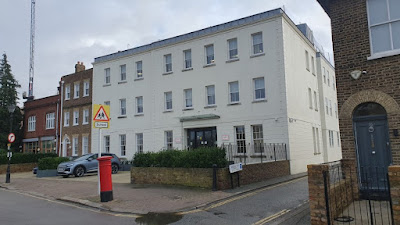 |
| February 2024 |
It's very nice.
Although, returning to my whinge that Infogrames rarely seemed to take me anywhere new, I should note that I've already been to both Richmond, for Melbourne House, and Hammersmith for Silversoft and Spirit Software.
Well not the building site, which is part of some giant City of London Corporation project called The Salisbury Square development. Infogrames Ltd moved to the building at the back of the picture, 8 Salisbury Square. Even here, the company didn't bring me anywhere new. Salisbury Square is just off Fleet Street, an area I visited when I was looking up Mirrorsoft and Piranha. This is where Infogrames Ltd was very quietly dissolved. Companies House changes the status of Infogrames to dormant in 2009. The move itself was part of the winding up process. KPMG Restructuring were the appointed liquidators, they were based at 8 Salisbury Square and moved the registered address there. The winding up process proceeded through its statutory steps until 19 September 2013.
Astonishingly this still isn't the end of the story. The end of the story isn't even the point in 2009 when IESA announced it would rebrand itself as Atari SA. Remember Infogrames Ltd? The UK company founded in 1986. It turned out to be The Little Company That Could...
Infogrames Ltd continued on after 2009. It's name wasn't changed to Atari anything but the company did move (or at least it's registered address did) in 2012 from Hammersmith to here.
8 Salisbury Square London
 |
| February 2024 |
Well not the building site, which is part of some giant City of London Corporation project called The Salisbury Square development. Infogrames Ltd moved to the building at the back of the picture, 8 Salisbury Square. Even here, the company didn't bring me anywhere new. Salisbury Square is just off Fleet Street, an area I visited when I was looking up Mirrorsoft and Piranha. This is where Infogrames Ltd was very quietly dissolved. Companies House changes the status of Infogrames to dormant in 2009. The move itself was part of the winding up process. KPMG Restructuring were the appointed liquidators, they were based at 8 Salisbury Square and moved the registered address there. The winding up process proceeded through its statutory steps until 19 September 2013.
Leave a comment or, if you have more or better, information, email whereweretheynow@gmail.com I'm shammountebank.bsky.social and shammountebank on Instagram. And by night I am the Phantom of the Opera! To the tower Rapunzel! Rapunzel!

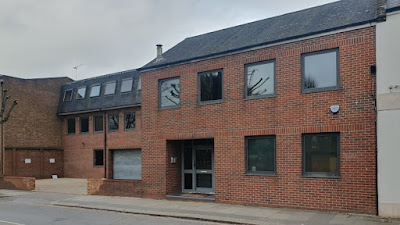
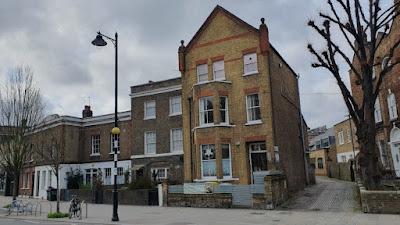

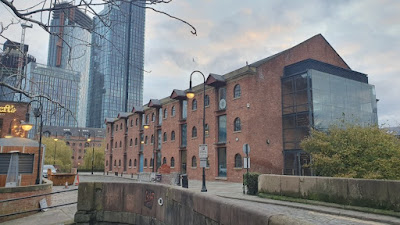
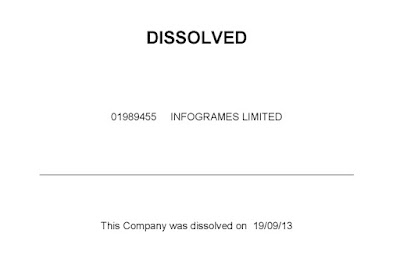






No comments:
Post a Comment